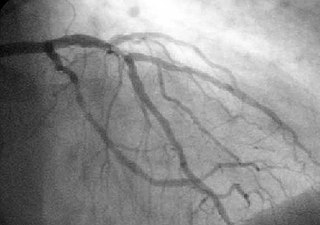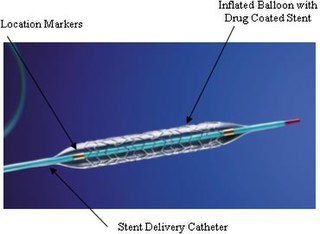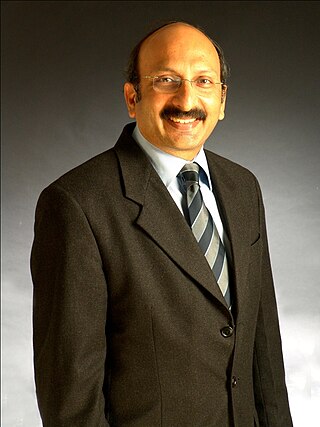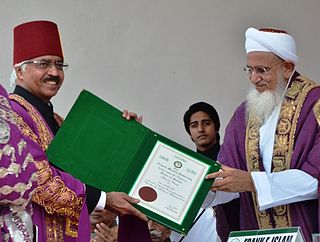Daljeet Singh Gambhir | |
|---|---|
| Born | Delhi, India |
| Occupation(s) | Interventional cardiologist Medical researcher Medical administrator |
| Known for | Multivessel angioplasty Medical research |
| Awards | Padma Shri DMA Life Time Achievement Award AACIO Distinguished Physician Award Government of Delhi State Award |
Daljeet Singh Gambhir is an Indian cardiologist, medical academic, researcher and inventor and the Group Director of Cardiology at Kailash Group of Hospitals and Heart Institute, Noida. [1] He is the inventor of Infinnium Paclitaxel-Eluting Stent, a reportedly cheaper drug-eluting stent which he first presented at the EuroPCR meeting held in Paris in 2003. [2] A fellow of the National Academy of Medical Sciences [3] and an honorary fellow of the Indian College of Cardiology, he is reported to have performed over 10,000 coronary interventions. [4] The Government of India awarded him the fourth highest civilian honour of the Padma Shri, in 2016, for his contributions to medicine. [5]
Daljeet Singh Gambhir graduated in medicine from Maulana Azad Medical College and followed it up with a post graduate degree (MD) from the same institution after which he secured the degree of DM. [6] He started his career as an assistant professor at the department of cardiology of Govind Ballabh Pant Institute of Postgraduate Medical Education, New Delhi in 1985 where he became a professor in 1993, at the age of 44. [7] During his tenure, he is known to have established a radiation therapy department at the hospital for the treatment of coronary restenosis. [8] Later he moved to Kailash Group of Hospitals where he is the group director of cardiology and the chief executive officer of its heart institute. [9]
Gambhir, known to have specialized in non-surgical coronary interventional techniques, is reported to have performed over 10,000 interventional procedures. [4] He is known to have conducted researches and clinical trials on various interventional techniques and invented a drug-eluting stent, known as Infinnium Paclitaxel-Eluting Stent, which was presented at the Paris EuroPCR meeting of 2003 after conducting clinical trials on 80 patients. [2] The stent was reported to have been more cost effective than the ones available at the market during that time. He has published over 110 articles in peer-reviewed journals and has contributed chapters to many medical text books published by others. [6] He is one of the founding members of the Indian College of Cardiology and a former president of the institution (2007–08), where he is a life member. [10] He is the clinical advisor to MIV Therapeutics, a medical institution working on biocompatible coatings for passive and drug-eluting stents, [8] and a consultant editor of the Indian Heart Journal. [11] He is a former president of the Cardiological Society of India (2002–03), chaired its scientific committee in 2002 and is a member of its executive committee. [12]
The National Academy of Medical Sciences elected Gambhir as their fellow in 2004. [13] He has received the State Award from the Government of Delhi as well as the Lifetime Achievement Award of the Delhi Medical Association. [4] The Government of India included him in the Republic Day honors list for the civilian award of the Padma Shri in 2016. [14] [15] He is also recipient of the Distinguished Physician Award of the Association of American Cardiologists of Indian Origin [7] and an honorary fellow of Indian College of Cardiology (2005), Cardiological Society of India (2006) and College of Asian Pacific Society of Cardiology (2007) and the American College of Cardiology. [9]

Coronary thrombosis is defined as the formation of a blood clot inside a blood vessel of the heart. This blood clot may then restrict blood flow within the heart, leading to heart tissue damage, or a myocardial infarction, also known as a heart attack.

Percutaneous coronary intervention (PCI) is a minimally invasive non-surgical procedure used to treat narrowing of the coronary arteries of the heart found in coronary artery disease. The procedure is used to place and deploy coronary stents, a permanent wire-meshed tube, to open narrowed coronary arteries. PCI is considered 'non-surgical' as it uses a small hole in a peripheral artery (leg/arm) to gain access to the arterial system; an equivalent surgical procedure would involve the opening of the chest wall to gain access to the heart area. The term 'coronary angioplasty with stent' is synonymous with PCI. The procedure visualises the blood vessels via fluoroscopic imaging and contrast dyes. PCI is performed by an interventional cardiologists in a catheterization laboratory setting.

A drug-eluting stent (DES) is a tube made of a mesh-like material used to treat narrowed arteries in medical procedures both mechanically and pharmacologically. A DES is inserted into a narrowed artery using a delivery catheter usually inserted through a larger artery in the groin or wrist. The stent assembly has the DES mechanism attached towards the front of the stent, and usually is composed of the collapsed stent over a collapsed polymeric balloon mechanism, the balloon mechanism is inflated and used to expand the meshed stent once in position. The stent expands, embedding into the occluded artery wall, keeping the artery open, thereby improving blood flow. The mesh design allows for stent expansion and also for new healthy vessel endothelial cells to grow through and around it, securing it in place.
The history of invasive and interventional cardiology is complex, with multiple groups working independently on similar technologies. Invasive and interventional cardiology is currently closely associated with cardiologists, though the development and most of its early research and procedures were performed by diagnostic and interventional radiologists.

A coronary stent is a tube-shaped device placed in the coronary arteries that supply blood to the heart, to keep the arteries open in patients suffering from coronary heart disease. The vast majority of stents used in modern interventional cardiology are drug-eluting stents (DES). They are used in a medical procedure called percutaneous coronary intervention (PCI). Coronary stents are divided into two broad types: drug-eluting and bare metal stents. As of 2023, drug-eluting stents were used in more than 90% of all PCI procedures. Stents reduce angina and have been shown to improve survival and decrease adverse events after a patient has suffered a heart attack—medically termed an acute myocardial infarction.

A bioresorbable stent is a tube-like device (stent) that is used to open and widen clogged heart arteries and then dissolves or is absorbed by the body. It is made from a material that can release a drug to prevent scar tissue growth. It can also restore normal vessel function and avoid long-term complications of metal stents.

Dr. Praveen Chandra is an Indian cardiologist and chairman of interventional cardiology at Medanta - The Medicity, Gurgaon, India. He is recognised for his work in the field of coronary angioplasty.

Purshotam Lal is an Indian Interventional cardiologist who has to his credit the pioneering of over 20 interventional cardiology procedures for the first time in India, some of which were the first time in the World. Trained in UK, US and Germany, and he has held various faculty positions including Professor, Advisor, etc.
A dual therapy stent is a coronary artery stent that combines the technology of an antibody-coated stent and a drug-eluting stent. Currently, second-generation drug-eluting stents require long-term use of dual-antiplatelet therapy, which increases the risk of major bleeding occurrences in patients. Compared to drug-eluting stents, dual therapy stents have improved vessel regeneration and cell proliferation capabilities. As a result, dual therapy stents were developed to reduce the long-term need for dual-antiplatelet therapy.
Mathew Samuel Kalarickal is an Indian cardiologist widely known as the father of angioplasty in India. He specializes in coronary angioplasty, carotid stenting, coronary stenting and rotablator atherectomy.

Ashok Seth is an Indian interventional cardiologist, credited with the performance of over 50,000 angiograms and 20,000 angioplasties, which has been included in the Limca Book of Records, a book for achievements and records from an Indian perspective. He is a Fellow of the Royal Colleges of Physicians of London, Edinburgh and Ireland and serves as the chief cardiologist, holding the chairs of the department of cardiovascular sciences and cardiology council at the Fortis Healthcare. Seth, a recipient of the Order of Isabella the Catholic, was honored by the Government of India with the fourth highest Indian civilian award of Padma Shri, in 2003, followed by Padma Bhushan, the third highest Indian civilian award, in 2015.

Tejas M. Patel is a cardiologist from Ahmedabad, India and chairman and chief interventional cardiologist at Apex Heart Institute, Ahmedabad. Patel, who has received the Dr. B. C. Roy Award, the highest Indian medical award, was honoured by the Government of India in 2015 with the Padma Shri, the fourth-highest Indian civilian award. In 2024, he was further recognized with the Padma Bhushan, the third-highest civilian award of the Republic of India, for his outstanding contributions to cardiology.
Elazer R. Edelman is an American engineer, scientist and cardiologist. He is the Edward J. Poitras Professor in Medical Engineering and Science at the Massachusetts Institute of Technology (MIT), Professor of Medicine at Harvard Medical School and at Brigham and Women's Hospital (BWH), and a practicing cardiologist at BWH. He is the director of the MIT Center for Clinical and Translational Research (CCTR), the Harvard-MIT Biomedical Engineering Center, and was previously director of the Institute for Medical Engineering and Science (IMES) at MIT. He is also the Program Director of the MIT Graduate Education in Medical Sciences program within the Harvard-MIT Division of Health Sciences and Technology.
Ashwin Balachand Mehta is an Indian cardiologist and one of the pioneers of interventional cardiology in India. He is the director of Cardiology department at Jaslok Hospital, Mumbai and also serves Breach Candy Hospital, as a consultant. He is reported to have performed the first Cardiac catheterization and Angiography in newborn babies in India, in 1973, the year when he introduced Bundle Electrography in the country. He is also credited with the performance or supervision of over 35,000+ angioplasties and over 75,000+ angiographies.
Upendra Kaul is an Indian cardiologist and one of the pioneers of interventional cardiology in India. He is the Chairman and Dean Academics and Research at the Batra Hospital and Medical Research Center. He is known for his expertise in procedures such as Percutaneous Cardiopulmonary bypass, Rotational and Directional Atherectomy, Coronary stenting and Percutaneous Laser Myocardial Revascularization. He graduated in medicine (MBBS) from the Maulana Azad Medical College and continued his studies at the same institution to secure MD in 1975 and, DM in cardiology in 1978. Later, he obtained advanced training in interventional cardiology from Australia during 1983 to 84. He has served the All India Institute of Medical Sciences (AIIMS) as a professor of cardiology and has been a member of the faculty of the Post Graduate Institute of Medical Education and Research, G. B. Pant Hospital, Batra Hospital and Fortis Health Care, NCR. and Executive Director and Dean at Fortis Health Care, New Delhi.

Kewal Kishan Talwar is an Indian cardiologist, medical academic and writer, and a former chairman of the Medical Council of India. He is a former director of the Post Graduate Institute of Medical Education and Research (PGIMER) and is reported to have performed the first implantation of Implantable cardioverter-defibrillator (ICD) therapy in South Asia. He is also credited with the introduction of Cardiac Resynchronization Therapy in India. He is a recipient of several honours including B. C. Roy Award, the highest Indian award in the medical category. The Government of India awarded him the third highest civilian honour of the Padma Bhushan, in 2006, for his contributions to medicine. Presently Dr. Talwar is working in PSRI Hospital Sheikh Sarai, New Delhi as the chairman of Cardiac Sciences
Sujoy Bhushan Roy was an Indian cardiologist and the founder Head of the department of the Cardiology at the All India Institute of Medical Sciences, Delhi. He was the president of the Cardiological Society of India in 1972. He was known for medical research in cardiology and was reported to have coined the name, Juvenile Rheumatic Stenosis. The Government of India awarded him the third highest civilian honour of the Padma Bhushan, in 1972, for his contributions to medical science.

Kamal Kumar Sethi is an Indian neurologist
Donald S. Baim was a researcher and clinician in the field of interventional cardiology. Baim's primary research focused on coronary blood flow, catheter intervention in heart disease, and congestive heart failure. His work helped to shift the use of catheters from a purely diagnostic tool to a therapeutic tool. After receiving a medical degree from Yale and initial medical training, residency and a fellowship at Stanford University Medical Center, Baim spent the bulk of his career at Beth Israel Hospital and at the Brigham and Women's Hospital in Boston. In 1993, Baim founded the Beth Israel Hospital's Cardiovascular Data Analysis Center (CDAC) -- later to be named Harvard Clinical Research Institute (HCRI). Baim died of cancer in November 2009. In October 2016, HCRI changed its name to the Baim Institute for Clinical Research.
Alfredo E. Rodríguez is an Argentine interventional cardiologist, clinical researcher, and author. He is the Chief of Interventional Cardiology Service at Otamendi Hospital and Director and Founder of the Cardiovascular Research Center (CECI) a non -profit Research Organization in Buenos Aires Argentina.